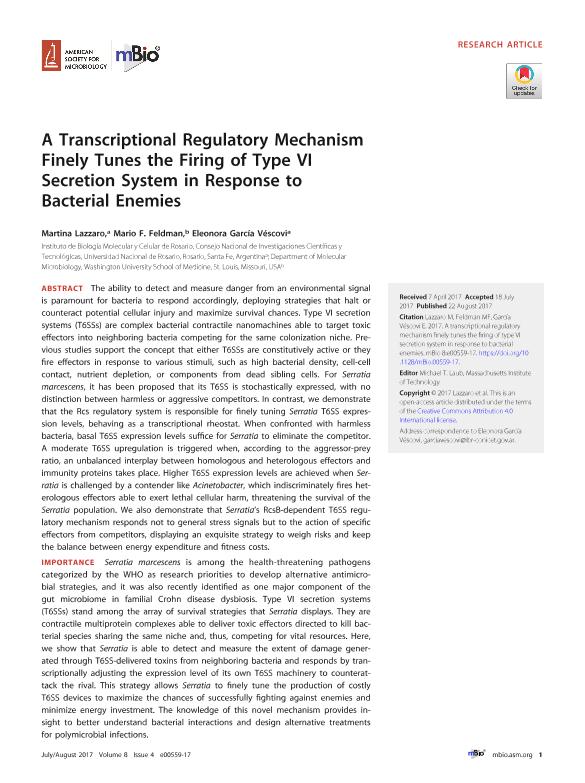Artículo
A Transcriptional Regulatory Mechanism Finely Tunes the Firing of Type VI Secretion System in Response to Bacterial Enemies
Fecha de publicación:
07/2017
Editorial:
American Society for Microbiology
Revista:
mBio
ISSN:
2161-2129
Idioma:
Inglés
Tipo de recurso:
Artículo publicado
Clasificación temática:
Resumen
The ability to detect and measure danger from an environmental signal is paramount for bacteria to respond accordingly, deploying strategies that halt or counteract potential cellular injury and maximize survival chances. Type VI secretion systems (T6SSs) are complex bacterial contractile nanomachines able to target toxic effectors into neighboring bacteria competing for the same colonization niche. Previous studies support the concept that either T6SSs are constitutively active or they fire effectors in response to various stimuli, such as high bacterial density, cell-cell contact, nutrient depletion, or components from dead sibling cells. For Serratia marcescens, it has been proposed that its T6SS is stochastically expressed, with no distinction between harmless or aggressive competitors. In contrast, we demonstrate that the Rcs regulatory system is responsible for finely tuning Serratia T6SS expression levels, behaving as a transcriptional rheostat. When confronted with harmless bacteria, basal T6SS expression levels suffice for Serratia to eliminate the competitor. A moderate T6SS upregulation is triggered when, according to the aggressor-prey ratio, an unbalanced interplay between homologous and heterologous effectors and immunity proteins takes place. Higher T6SS expression levels are achieved when Serratia is challenged by a contender like Acinetobacter, which indiscriminately fires heterologous effectors able to exert lethal cellular harm, threatening the survival of the Serratia population. We also demonstrate that Serratia’s RcsB-dependent T6SS regulatory mechanism responds not to general stress signals but to the action of specific effectors from competitors, displaying an exquisite strategy to weigh risks and keep the balance between energy expenditure and fitness costs. IMPORTANCE Serratia marcescens is among the health-threatening pathogens categorized by the WHO as research priorities to develop alternative antimicrobial strategies, and it was also recently identified as one major component of the gut microbiome in familial Crohn disease dysbiosis. Type VI secretion systems (T6SSs) stand among the array of survival strategies that Serratia displays. They are contractile multiprotein complexes able to deliver toxic effectors directed to kill bacterial species sharing the same niche and, thus, competing for vital resources. Here, we show that Serratia is able to detect and measure the extent of damage generated through T6SS-delivered toxins from neighboring bacteria and responds by transcriptionally adjusting the expression level of its own T6SS machinery to counterattack the rival. This strategy allows Serratia to finely tune the production of costly T6SS devices to maximize the chances of successfully fighting against enemies and minimize energy investment. The knowledge of this novel mechanism provides insight to better understand bacterial interactions and design alternative treatments for polymicrobial infections.
Palabras clave:
Bacterial Competition
,
Serratia
,
Type Vi Secretion System
Archivos asociados
Licencia
Identificadores
Colecciones
Articulos(IBR)
Articulos de INST.DE BIOLOGIA MOLECULAR Y CELULAR DE ROSARIO
Articulos de INST.DE BIOLOGIA MOLECULAR Y CELULAR DE ROSARIO
Citación
Lazzaro, Martina; Feldman, Mario F.; Garcia Vescovi, Eleonora; A Transcriptional Regulatory Mechanism Finely Tunes the Firing of Type VI Secretion System in Response to Bacterial Enemies
; American Society for Microbiology; mBio; 8; 4; 7-2017; 1-17; e00559-17
Compartir
Altmétricas




